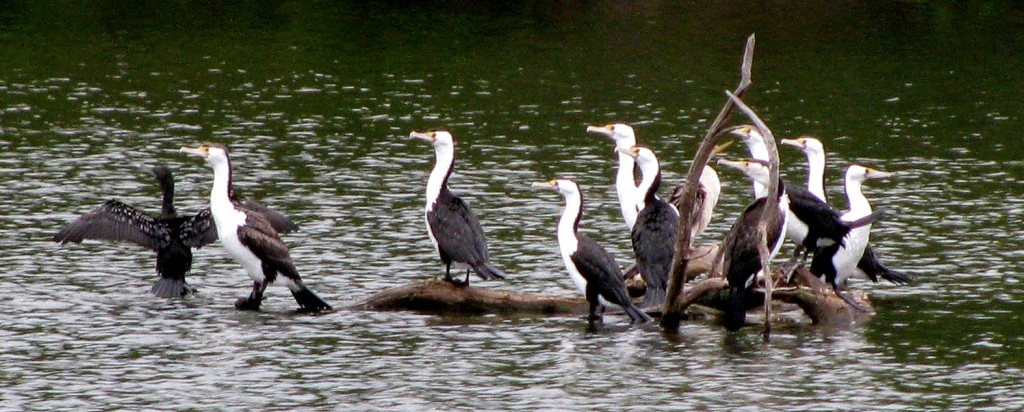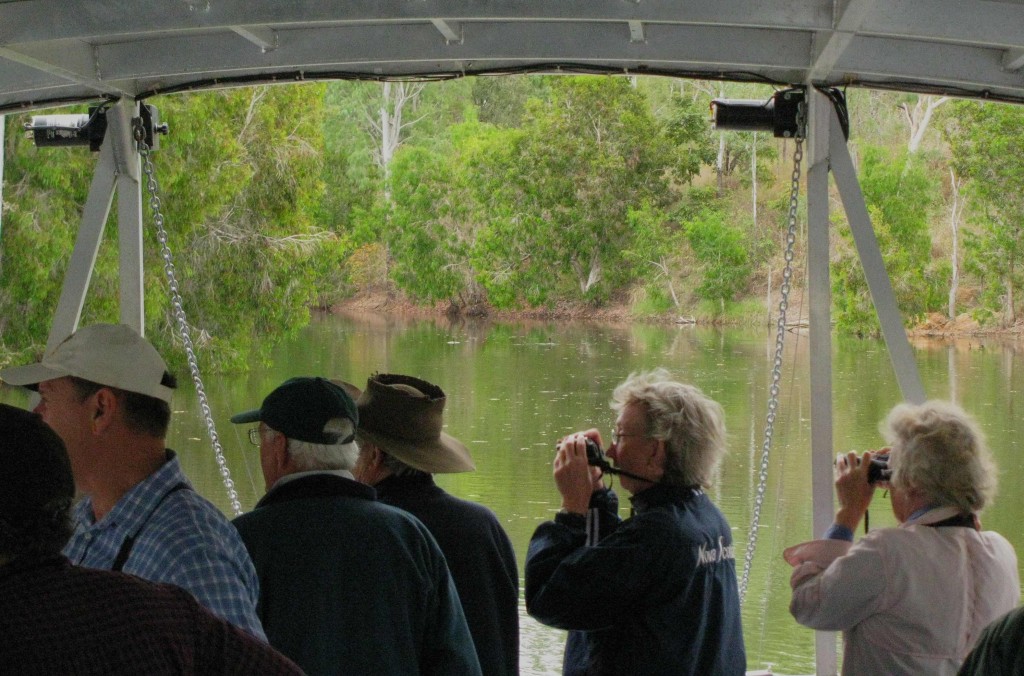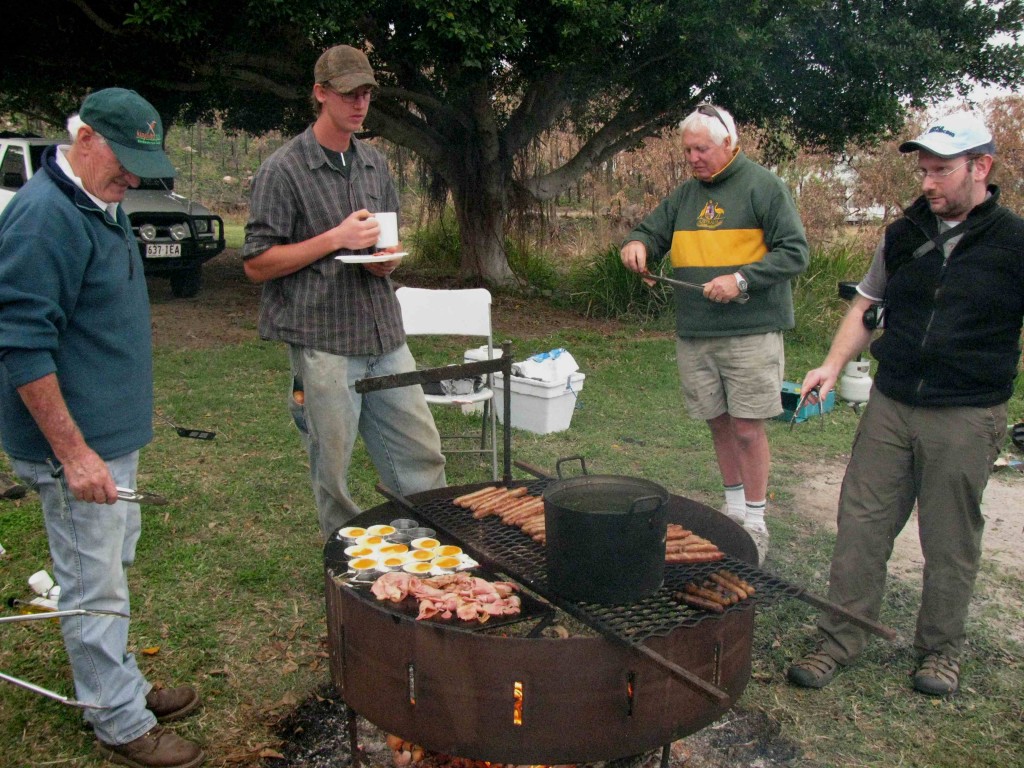Birding and breakfast were the orders of the morning, since the Townsville Region Bird Observers Club had organized a cruise on Ross Lake and Ross River to be followed by breakfast on the shore of the lake. Vilis, Janis (who returned from Bundaberg last evening), and I scrambled out of bed at 5 a.m., consumed bowls of cereal to tide us over for the duration of the two-and-a-half-hour cruise, and joined members of the birding club at the Ross River Dam at 6:15 a.m. We boarded a bus for the short drive past the dam’s triple spillway and along the lakeshore to Pop Sullivan’s cruise boat moored at the lakeside. While black kites soared overhead and allied rock wallabies bounded over boulders buttressing the dam, scarlet-billed Caspian terns winged gracefully over the water and dove to its surface to capture food.

Little Black Cormorant and Pied Cormorants on Ross Lake (© Vilis Nams)
Once the 40 or so passengers had boarded the cruise boat, we headed out across the expanse of the man-made lake, which serves as a water supply for Townsville. Drowned treetops and floating logs protruding from the dull grey water served as perches for a rich assemblage of water birds that included pied cormorants, great egrets, Australian pelicans, anhingas, little pied cormorants, little black cormorants, and others. Elegant black swans swam with cygnets beside or behind them, and flushed into the air at the boat’s passing, their white wingtips flashing as they raced across the lake surface, feet patting the water and long wings slapping up splashes. “They need a long runway,” one birder commented, and we all watched with mixed feelings as a white-bellied sea eagle snatched up a frantically-paddling cygnet that had been separated from its parent by the boat’s passage.

Here I am (wearing Nova Scotia jacket) with TRBOC members scanning Ross River banks for birds (© Vilis Nams)
On the south side of the lake, we entered the mouth of the Ross River and cruised slowly upstream, all binoculars scanning the riverside paperbarks for great cormorants, Nankeen night herons, and little kingfishers. We dipped on the little kingfishers, but observed dozens of great cormorants – a new species for me – perched in trees, lifting from the water, and flying along the river with long necks extended and yellow face patches clearly visible. I scored another first when an immature Nankeen night heron flushed from its perch and flew upstream before landing on an exposed branch that offered an excellent view of its mottled, pale cinnamon plumage. We spotted great crested grebes diving for fish at the edges of patches of floating vegetation, and heard and observed woodland birds – honeyeaters, white-browed robin, yellow-bellied flycatcher, Australian brush-turkeys – living on the river’s edge.
After the boat reached its upstream limit, it retraced its path, offering us more views of artistically-arranged little black cormorants perched on branches, and of anhingas (also called darters or snakebirds) raising their stilleto beaks to the sky. Some of the latter, with wings too wet to fly, abandoned their perches at the boat’s approach and dove into the river. White-breasted woodswallows circled and swooped overhead, and a pair of Indian peafowl meandered among the paperbarks growing beside the river, the male respendant in his brilliant blue and green plumage.
During a lull in the sightings, an elderly fellow who recognized the ‘Nova Scotia’ on the back of my jacket as representing a region of Canada said to me, “Do you know what the nicest thing is that Canadians have done for us during the past few years?” When I replied that I didn’t, he explained that, while hosting an international sporting event, Canada had welcomed the Australian contingent by playing Australia’s national anthem, and then played Happy Birthday in recognition of the centennial of Australia becoming an independent country. “There wasn’t a dry eye in the country back here, ” he added, smiling nostalgically.
As the cruise boat headed back out onto the lake, our view included distant ranges of sharp-peaked hills and a cloud-blanketed sky spilling white rain onto Mount Elliot. The lakeshore slopes slanting up to Mount Stuart resembled a painting in shades of sepia and ochre touched with olive, their vegetation scorched by a prescribed burn.
After hours on the water, buffeted by breezes and invigorated by morning air and the intensity of birding, Vilis, Janis, and I were pleasantly surprised by the lakeshore breakfast, which far exceeded our expectations. Lashings of fruits, sausages, bacon, eggs, baked beans, and toast were provided, their preparation and consumption offering a relaxed atmosphere for chit-chat. Vilis and Janis hobnobbed with the fellows cooking breakfast, and I was invited to a beginner’s workshop on identifying shorebirds, which is to be held at Cungulla in early October. Based on the success of this event and other TRBOC events I’ve attended, it’s bound to be good, which will be helpful since I’m not good with shorebirds. However, with that workshop under my belt and some shorebird experts on hand to offer advice, even I should be able to face the mudflats of Cungulla with equanimity.

Lakeshore breakfast cooking, with Janis at back left (© Vilis Nams)
Today’s fauna: black kites, allied rock wallabies, whistling kites, Caspian terns, pied cormorants, great egrets, Australian pelicans, black swans, masked lapwings, little egrets, willie wagtail, black-necked storks, royal spoonbills, Australian bustard, white-bellied sea eagle, blue-winged kookaburras, little black cormorants, little pied cormorants, agile wallabies, *great cormorants, sacred kingfishers, magpie-lark, yellow honeyeaters, *Nankeen night heron, great crested grebes, white-faced heron, white-browed robin, brush cuckoo, brown honeyeater, laughing kookaburras, Australian brush-turkeys, white-breasted woodswallows, Indian peafowl, yellow-bellied flycatcher, wedge-tailed eagle, red-tailed black-cockatoos, rainbow lorikeets, Australian white ibis, intermediate egret, Torresian crow, mynas, bush stone-curlew. (*denotes lifelist sighting)


